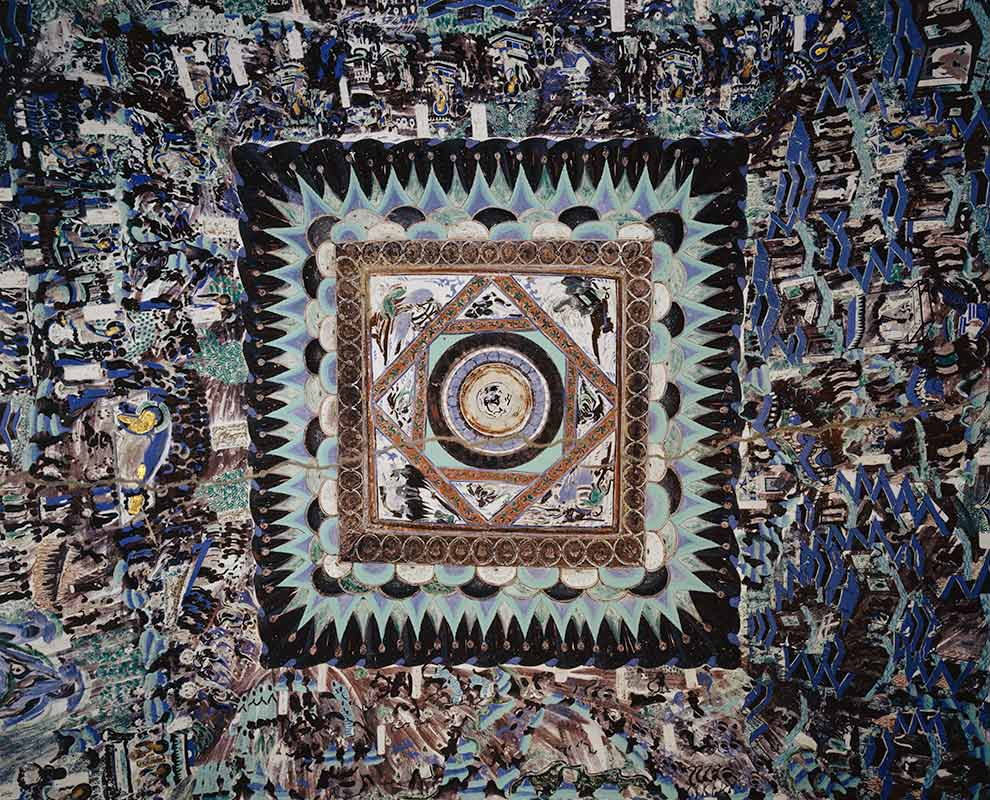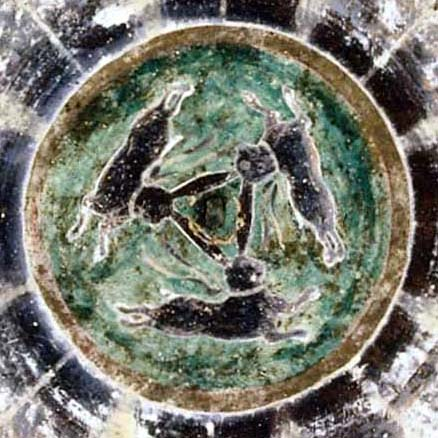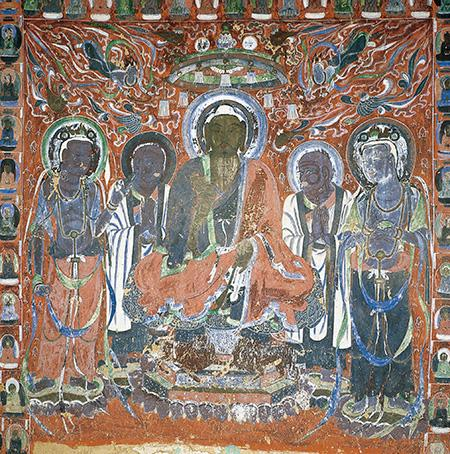Stairways to the Buddha Land
Stairways to the Buddha Land: Caisson Ceilings in Buddhist Temples Revisited
Text | Jeanne H. Tuan
A heart-beating advertising slogan from a commercial columbarium once horns its interior adornments and solemn atmosphere: "As Michelangelo's Sistine Chapel ceiling frescoes, the Buddhist temple's caisson ceiling painting shows you a stairway to heaven." The metaphor of "a stairway to heaven" for a caisson is fascinating and mysterious for the issue of life and death. A caisson, or "zaojing" (literally algae well) in Chinese, sounds odd to most ears, though.
"What is a caisson?" is a common FAQ when the word first comes to mind. A caisson, an architectural term, is a recessed panel on the ceiling top with multi-layers and rich adornments in Chinese architecture. Typical shapes of caisson ceilings include squares, octagons, hexagons, circles, and a combination of these. A highly decorated caisson is placed at the most attractive spot to highlight the most critical space in a temple. Surrounded by brackets continuously from the outer to the center, a caisson looks like a well from a worm's eye.
The rich ornamentation of a caisson ceiling often conveys cultural, historical, and religious significance in the chosen themes or motifs on display. To make it more extreme, it provides an intriguing insight into Buddhism's religion and culture. Here's a look at two of Buddhism's most well-known caisson ceilings, each stunning icon of the faith.
Great Compassion Mantra Caissons in the Fo Guang Shan Buddha Museum
At the top of the list of museum treasures, the reconstruction of the Great Compassion Mantra Caissons in the Buddha Museum is an extraordinary artwork to behold. These large-scale paintings on wooden panels, which blend art and religion, consist of the Central Caisson flanked by the Caisson of Dragon and the Caisson of Tiger. Originally adorning the ceiling of Longhu Nunnery in Kaohsiung, Taiwan, these caissons were gifted to the Buddha Museum when Longhu Nunnery underwent demolition and temple reconstruction in 2017.

Picture 1: Great Compassion Mantra Caissons at the Fo Guang Shan Buddha Museum
The three wooden Caissons paint the eighty-four manifestations of Avalokitesvara Bodhisattva and corresponding verses in the Great Compassion Mantra. The Great Compassion Mantra in Sanskrit was transliterated into Chinese characters by Bhagavaddharma, an Indian monk in the 7th century. The Chinese rendition acquired a new form of eighty-four lines. Mentioned in the Lotus Sutra, a canonical text of Buddhism, Avalokitesvara Bodhisattva works tirelessly in different manifestations, all to suit the minds of various beings, to help those who call upon his name and cry for his help. Besides, the images of Vaiśravaṇa, Virūḍhaka, Dhṛtarāṣṭra, and Virūpākṣa, the four deva kings and protectors of cardinal directions of the world, appear on the caissons.

Picture 2: Close-Up of Avalokitesvara Bodhisattva's Facial Features
In terms of formal aspects of artistic skills, the artists rendered the text and inscriptions in a clerical script. Under the influence of modern Western art schools, the artists also skillfully applied colors using fingers and palms to create a subtle gradient effect on each bodhisattva's face and hands and imbue them with a three-dimensional appearance, shown in Picture 2.
The kernel of the Central Caisson in Picture 3, with the pattern of concentric circles bearing the Chinese characters for "Hsing" (meaning "mind") and "Fo" (representing "Buddha"), captivates the viewers' eyes and souls. This design symbolizes that a purified mind leads to enlightenment and moves toward a "Buddha Land."

Picture 3: The Central Caisson adorned with Chinese characters "Hsing" and "Fo" in concentric circles
In the meantime, it raises the question in no minute: "How can one purify their mind?" The Great Compassion Caissons, a seamless blend of art and religion, suggests that one should emulate the wholesome deeds of Avalokitesvara Bodhisattva and take the track of the Bodhisattva Path by practicing the six paramitas: giving, precepts, patience, diligence, Samadhi, and wisdom. By doing so, everyone can become newly inspired Living Bodhisattvas and step on the stairway to Buddha Land. The Great Compassion Caissons, as a religious cornerstone, reminded us of the importance of virtuous actions and the pursuit of spiritual purification, as depicted through exquisite artwork and religious symbolism.
Three Hares Chasing in the Lotus: Caisson Ceiling of Dunhuang Mogao Cave 407
Kanishka I (c 127 to 150 CE), an illustrious emperor of the mighty Kushan Dynasty, is credited with a critical role in transmitting Mahayana Buddhism to Central Asia and China. Since then, the Silk Roads have experienced a remarkable surge as crucial channels for intercultural exchanges. Trade, technology, folk cultures, languages, and diplomacy between East and West were primarily conducted on the Silk Roads, formulating networks. They played an important role in connecting Han Chinese, Kushaneans, Persians, and Romans. It is speculated that unofficial emissaries of Buddhism, including groups of caravans and merchants traveling on the Silk Roads, likely came to China around 127 CE or within a few years of that time.
Despite its remote and isolated location, Dunhuang was a significant crossroads between the East and West. Flourishing as an oasis on the edge of the Taklamakan Desert along the Silk Road from the 4th to the 14th centuries, the city became a thriving center for military, arts, and cultural exchange between diverse civilizations and religions. Dunhuang boasted a sprawling metropolis in medieval China. Notably, the Mogao Grottoes, a series of cave temples located on the southeast outskirts of Dunhuang, contains exquisite examples of Buddhist art spanning a thousand years. The wall paintings and sculptures within the cave temples also provide insights into the inhabitants' lifestyles and the foreign influences on the art of that time.
Mogao Cave 407 exemplifies a remarkable fusion of motifs from India, Iran, Central Asia, and China. Established during the Sui Dynasty between 581-618 CE, this cave features a caisson pattern that embellishes the center of the truncated pyramid ceiling. The caisson pattern showcases a large eight-petalled multi-layered lotus flower, within which three hares chase each other in an anticlockwise direction. Interestingly, each hare only reveals one ear, creating the illusion of two ears as they conjoin to form a triangle . This ingenious design accentuates the hares' rotational movement and adds visual depth to the artwork.
Surrounding the lotus motif, figures of apsaras, monks, and boys are depicted moving in an anticlockwise motion to echo the direction of the hares' gallop. The multi-layered borders of the square well are meticulously adorned with compact and structured patterns of various designs, showcasing the exquisite craftsmanship of caisson design during the peak of Buddhism in China.

Picture 4: Caisson Ceiling of Mogao Cave 407 in the Sui Dynasty (581-618 CE.), featuring the Three Hares motif
About three hares racing around in an endless circle, the motif’s origin is still a topic of scholarly debate. In fact, this motif has been found in various regions, including China, Iran, Central Asia, and Europe, to indicate its widespread presence. Some scholars speculate that the motif may have originated in ancient Persia when trade along the Silk Roads was thriving, as the symbol found in Islamic art and architecture dating back to the 9th century.

Picture 5: Detailed view of the Three Hares Motif on the Caisson Ceiling of Mogao Cave 407
The mysterious symbol of a trio of hares holds significant meaning in Buddhist culture, in spite of its unclear origin. The images of hares represent the unending cycle of birth, death, and rebirth in samsara, which leaves indelible karmic imprints. Metaphorically, the agility of a hare is insufficient to escape the powerful cycle of samsara that keeps life bound to the material world. In contrast, the lotus flower is a powerful symbol of purity and enlightenment in Buddhism. The lotus grows out of muddy water, but remains untouched by the impurities of its environment, just as a person can attain enlightenment and liberation from suffering despite living in a world full of suffering and delusion.
.png)
Picture 6: Iranian brass tray, inlaid with copper, dating from the late 12th or early 13th century. Courtesy of Chris Chapman, Copyright Owner
One naturally ponders upon the question when considering how to break free from the cycle of samsara and achieve purity and enlightenment. The mural below the caisson ceiling, strongly influenced by the Indian painting style, displays vibrant colors and delicate depictions of Sakyamuni Buddha teaching the dharma to sentient beings with his disciples Mahakasyapa and Ananda by his side. The composition implies that by comprehending the Four Noble Truths, cultivating the Six Paramitas, and following the Noble Eightfold Path, one can reach the Bodhisattva path and ultimately the Buddha land.

Picture 7: Mural above the entrance on the east wall of Mogao Cave 407 in the Sui Dynasty (581-618 CE.), featuring Buddha Teaching the Dharma
The Great Compassion Caissons at the Fo Guang Shan Buddha Museum and the Three Hares Chasing in the Lotus motif in Dunhuang Mogao Cave 407 act as spiritual mirrors, reflecting the virtues of compassion and moral purity. They invite us to delve deep into our souls, to ignite the divine flame of awareness and self-realization. These religious symbols are like seeds, sowing the essence of spirituality and inspiring us to cultivate the fertile ground of our hearts. With their intricate designs and elaborate details, the caisson ceiling paintings serve as a stairway to the sublime. They are a symbolic gateway that leads us toward the Buddha Land when we believe in Mahayana Buddhism's core values, take bodhisattvas’ vows to benefit others, and practice them daily.